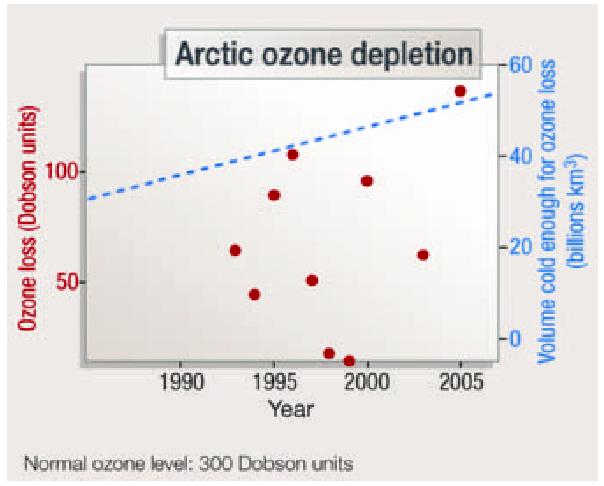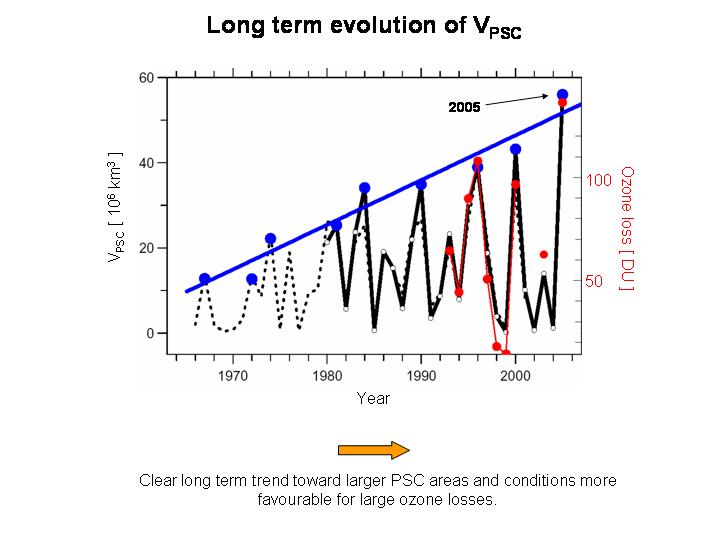To our readers who have followed the supposed ‘hockey stick controversy’, this press release from NCAR just out today, will be of interest.
Archives for 2005
2005 Record Arctic Ozone Loss
You read it here first!
Update (09/05/05): Markus Rex was kind enough to send us the full figure from which Nature made their thumbnail, and which is a little clearer. He also cautions that the 2005 numbers are still preliminary, however there is a clear trend towards increasing potential for Arctic ozone loss, which is realised or not depending on the vagaries of each individual winter.
Storms and Climate Change
The Atlantic hurricane season will soon be upon us again , and no doubt many people will recall last year’s devastating Hurricanes that swept across Florida. There was a great deal of press about these storms, as 3 major hurricanes and 5 tropical storms made landfall in the US. According to HurricaneProtection.com, the last time eight different tropical cyclones impacted the United States coastline in a single season was 1916. There were a total of 15 tropical storms and hurricanes, which means that the total number of storms that year was higher than 95% of the previous years of hurricane observations. There was also a record number of Typhoons over Japan in 2004 (10! The previous record was 6 from 1996) . Typhoons are the same as Hurricanes, but have a different name over the Indian ocean and the western Pacific. They are also known as ‘tropical cyclones’. Furthermore, it was the first time that a tropical cyclone had been observed in the south Atlantic (see WMO Climate News, Jan 2005, p. 12)! So, what’s going on?
Planetary energy imbalance?
The recent paper in Science Express by Hansen et al (on which I am a co-author) has garnered quite a lot of press attention and has been described as the ‘smoking gun’ for anthropogenic climate change. We have discussed many of the relevant issues here before, but it may be useful to go over the arguments again here.
The key points of the paper are that: i) model simulations with 20th century forcings are able to match the surface air temperature record, ii) they also match the measured changes of ocean heat content over the last decade, iii) the implied planetary imbalance (the amount of excess energy the Earth is currently absorbing) which is roughly equal to the ocean heat uptake, is significant and growing, and iv) this implies both that there is significant heating “in the pipeline”, and that there is an important lag in the climate’s full response to changes in the forcing.
Technical problem apology
Due to some odd behaviour with our blog software, many people have had problems this week posting comments. We would like to apologise to our readers if they encountered these problems (bizarre redirections and WordPress login screens appearing where they shouldn’t).
We appear to have fixed the problem (fix from here for those interested), but please let us know if anything weird or unusual continues to occur. Thanks for your patience.
Normal service will resume after the break.
Pollution-Climate Connections
Guest commentary by Loretta Mickley, Harvard University
Every summer over much of the United States, we brace ourselves for heat waves. During these periods, the air turns muggy and usually smoggy. After a few days, a cold front moves in, sweeping away the pollution and ending the heat. Given that we are on a path towards global warming, atmospheric chemists are asking how climate change could affect air quality. Will warmer temperatures mean more pollution during these episodes? Will episodes last longer? Most importantly, what effect will changes in air quality have on human health?
Retreating Glacier Fronts on the Antarctic Peninsula over the Past Half-Century
Guest commentary by David Vaughan
 The recent retreat of ice shelves on the Antarctic Peninsula has been widely attributed to warming atmospheric temperatures. There is, however, little published work describing the response of glacier margin positions to this regional climate change. In the paper Retreating Glacier Fronts on the Antarctic Peninsula over the Past Half-Century published this week in Science, we presented new data describing trends in 244 marine glacier fronts on the Antarctic Peninsula over the last 50 years. The data come from matching archives of over 2000 aerial photographs of the Antarctic Peninsula to satellite images, and represent about three years of work by Alison Cook. The work was carried out at British Antarctic Survey, but was funded by the US Geological Survey, as part of a larger programme to map change in the coastline of all Antarctica.
The recent retreat of ice shelves on the Antarctic Peninsula has been widely attributed to warming atmospheric temperatures. There is, however, little published work describing the response of glacier margin positions to this regional climate change. In the paper Retreating Glacier Fronts on the Antarctic Peninsula over the Past Half-Century published this week in Science, we presented new data describing trends in 244 marine glacier fronts on the Antarctic Peninsula over the last 50 years. The data come from matching archives of over 2000 aerial photographs of the Antarctic Peninsula to satellite images, and represent about three years of work by Alison Cook. The work was carried out at British Antarctic Survey, but was funded by the US Geological Survey, as part of a larger programme to map change in the coastline of all Antarctica.
[Read more…] about Retreating Glacier Fronts on the Antarctic Peninsula over the Past Half-Century
Ozone depletion and global warming
One of the most common mistakes that we have observed in discussions of climate and atmospheric change is confusion between the rather separate concepts of ozone depletion and global warming. This isn’t necessarily surprising given the scant information that most people pick up from the media. However, for many years meteorologists have been fighting a rearguard action to persuade people that the globe isn’t warming because there is more sun coming through the ozone hole. There are however important connections between the two issues that complicate potential actions that we might take to alleviate the different problems. This week, for instance, a new IPCC report was released that looked at the greenhouse warming potential of many of the replacement chemicals (HFCs and HCFCs) that were used to replace CFCs in aerosol cans and refrigeration units under the Montreal Protocol (and subsequent amendments).
Water vapour: feedback or forcing?
Whenever three or more contrarians are gathered together, one will inevitably claim that water vapour is being unjustly neglected by ‘IPCC’ scientists. “Why isn’t water vapour acknowledged as a greenhouse gas?”, “Why does anyone even care about the other greenhouse gases since water vapour is 98% of the effect?”, “Why isn’t water vapour included in climate models?”, “Why isn’t included on the forcings bar charts?” etc. Any mainstream scientist present will trot out the standard response that water vapour is indeed an important greenhouse gas, it is included in all climate models, but it is a feedback and not a forcing. From personal experience, I am aware that these distinctions are not clear to many, and so here is a more in-depth response (see also this other attempt).
Doubts about the Advent of Spring
A “consensus view” amongst climate scientists holds that the Northern Hemisphere will be warming this month, as spring is coming. This is thought to be due to the Earth’s orbit around the sun and the inclination of the Earth’s axis, tilting the Northern Hemisphere progressively towards the sun throughout March and April and increasing the amount of solar radiation received at northern latitudes.
In a new novel, State of Euphoria, bestselling author Michael Crikey uncovers major flaws in this theory and warns against false hopes for the arrival of spring.
[Read more…] about Doubts about the Advent of Spring


